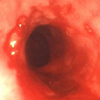- Anatomy of the gastrointestinal system
- Coeliac disease (gluten-sensitive enteropathy, coeliac sprue)
- Common coeliac disease symptoms
- Endoscopy
- Gluten free diet
Anatomy of the gastrointestinal system
 |
The gastrointestinal tract (GIT) consists of a hollow muscular tube starting from the oral cavity, where food enters the mouth, continuing through the pharynx, oesophagus, stomach and intestines to the rectum and anus, where food is expelled. |
For more information, see Gastrointestinal System.
Coeliac disease (gluten-sensitive enteropathy, coeliac sprue)
 |
Coeliac disease is a chronic inflammatory disease of the small bowel. In genetically susceptible individuals, ingestion of gluten (a protein found in wheat, barley and rye) causes injury to the lining of the small bowel, resulting in diarrhoea and malabsorption of nutrients and minerals. |
For more information, see Coeliac Disease (Gluten-Sensitive Enteropathy, Coeliac Sprue).
Common coeliac disease symptoms
Steatorrhoea
 |
Steatorrhoea is a condition characterised by an increase in fat content in stools leading to the production of pale, bulky, offensive and loose stools. |
For more information, see Steatorrhoea.
Diarrhoea
 |
Diarrhoea is a common digestive disorder that virtually all people will suffer at some stage during their lives. The definition of diarrhoea varies but it can generally be taken to mean increased stool water causing an increase in stool frequency or the passage of soft stools. |
For more information, see Diarrhoea.
Abdominal pain
 |
Abdominal pain is a very common medical condition that can either be acute or chronic in nature. Basically it refers to pain that is felt within the abdomen which is the region of the body bounded by the ribs superiorly and the pelvis below. |
For more information, see Abdominal Pain.
Nausea and vomiting
 |
Nausea is an unpleasant sensation of wanting to vomit, and is often associated with cold sweat, pallor, salivation, loss of gastric tone, duodenal contraction, and the reflux of intestinal contents into the stomach. Nausea generally precedes vomiting, but can occur by itself. |
For more information, see Nausea and Vomiting.
Flatulence (gas)
 |
Flatulence refers to the passage of gastrointestinal gas (flatus) under pressure via the rectum and anus (back passage). In colloquial terms this is referred to as ‘farting.’ |
For more information, see Flatulence (Gas).
Abdominal bloating
 |
Abdominal bloating is felt by patients as a feeling of fullness, tightness or distension in the abdomen. Bloating is different to abdominal swelling, where the abdomen is actually increased in size, although both of these features may be present. |
For more information, see Bloating.
Endoscopy
 |
Upper endoscopy, also referred to as oesophagogastroduodenoscopy (OGD), is a procedure that allows a doctor to examine the state of the upper gastrointestinal tract (i.e. the oesophagus, stomach and duodenum). It involves the insertion of an endoscope (a long flexible tube with a camera at the end) into the gastrointestinal tract through the mouth. |
For more information, see An Introduction to Endoscopy,
Gluten free diet
 |
A gluten free diet, as the name suggests, is a diet free of gluten. Gluten is a storage protein derived from wheat, barley, rye and a number of other cereals, and thus is commonly found in modern diets. |
For more information, see Gluten Free Diet,
All content and media on the HealthEngine Blog is created and published online for informational purposes only. It is not intended to be a substitute for professional medical advice and should not be relied on as health or personal advice. Always seek the guidance of your doctor or other qualified health professional with any questions you may have regarding your health or a medical condition. Never disregard the advice of a medical professional, or delay in seeking it because of something you have read on this Website. If you think you may have a medical emergency, call your doctor, go to the nearest hospital emergency department, or call the emergency services immediately.







